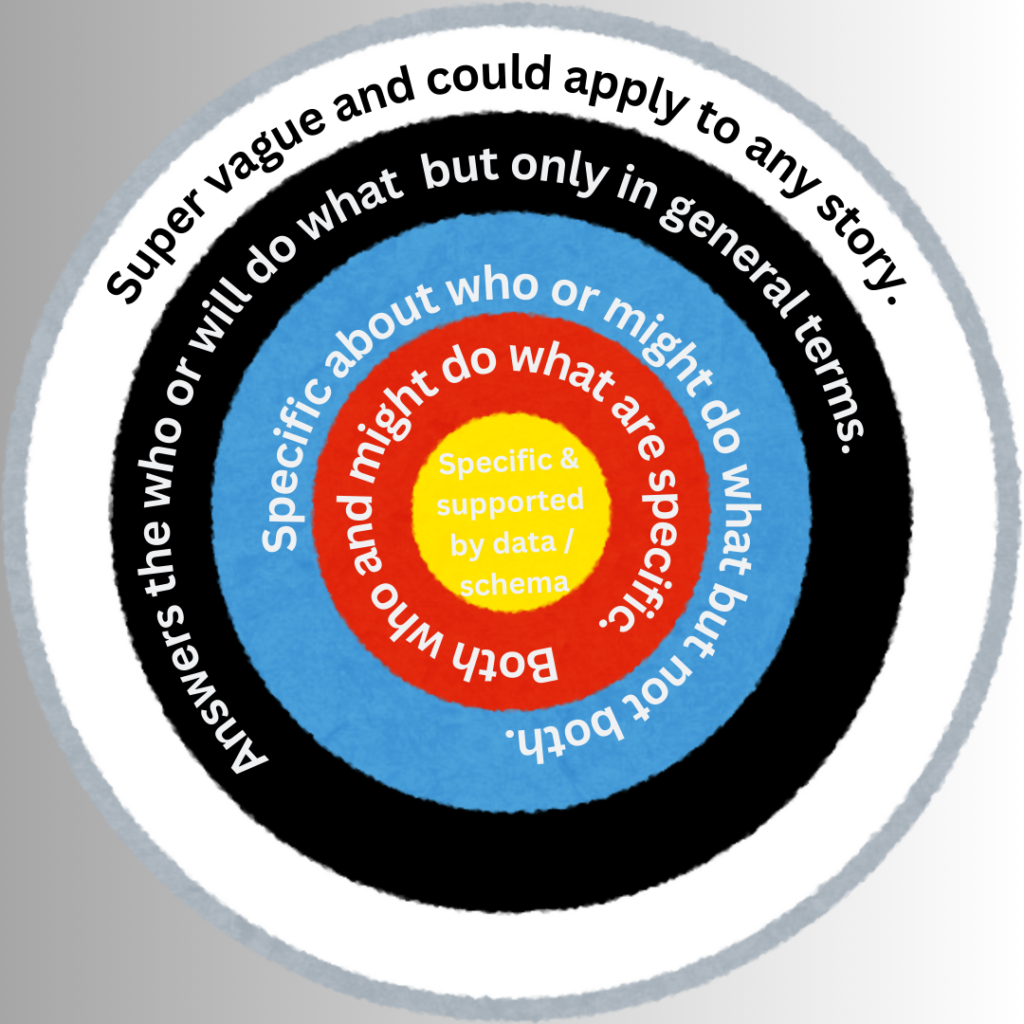
When kids first start making predictions they are often so concerned with being accurate that they don’t add any detail to their predictions. The vagueness of their predictions is only matched by the vagueness of someone with something to hide. You know the predictions – “Something bad is going to happen.” “There will be a problem in this story.” “Everything will turn out okay at the end.” These are last ring of the target type predictions. If the predictions had been arrows they would only hit the one point ring. Technically they are predictions but they give no details. They aren’t helping to open schema files beyond the super generic ones that almost always get opened anyway. This type of predictions are about as helpful as the wildly off the target guesses that aren’t based in any data or schema. As the adult, it is your job to help children aim for the inner rings and ultimately for that 10 point bullseye. Let’s look at how we can help move children towards specific and helpful predictions.
Step 1: Remind everyone that making an inaccurate prediction is not failing! The only way to fail at making a prediction is not using the data or your schema to make an informed look towards what COULD happen.
Step 2: Ask questions. If your student says something like, “There will be a problem in this story because every story has a problem.” as their prediction, it becomes your job to ask them questions to force them to qualify their answer. “What do you think the problem might be?” “Who will be involved in the problem?” We’re aiming for 3 or 4 points now.
Step 3: Aid in refining the prediction. Once predictions become a bit more specific such as, “I predict that Max will be upset because his brothers won’t share with him.” continue to focus your child in with a question such as “What kinds of things might Max do because he is upset?” We are looking for kids to give us specific things that may happen. We want them to dig into those schema files. At this point, we’re nearing those 6 or 7 point scoring rings.
Step 4: Help children regulate their predictions themselves. Work with them to ask questions like, “Did I specifically name who would be involved?” “Did I specifically name what might happen?” “Did I clearly share what data I used to make my prediction?” If they can answer yes to all three of those questions they’ve aimed for the bullseye. They’ve reached that 10 point center. Does this mean that their prediction will be 100% correct? Surely not. But it does mean that they have properly opened schema files in a way that will be useful for them as they move forward.
One way that I help my kids and the other children that I teach as we are learning to aim for the bullseye during predictions is I show them the prediction bullseye. This helps them to judge their own “prediction score” before even bringing it to the table during a group discussion or before writing it down during independent work. After using the bullseye repeatedly, I will place a bullseye on the table during our discussions and we will “shoot” the target where we think someone’s prediction falls with miniature marshmallow arrow bows just for fun. The greater part of is activity comes not from where the marshmallow and toothpick arrows fall but rather from the discussion about where they were aiming and why they choose that ring. Shortly after introducing the bullseye, predictions drastically improve. Everyone wants to hit the center.

If it wouldn’t cause a huge problem in your family, you could even make it into a competition. We don’t need to add any more competitive spirit to our house of four boys but I do know of families who have successfully added this component.
By teaching your brain to make predictions out of the words and pictures of a text as well as your schema, you are training it to be prepared for what may lie ahead, you are giving yourself a leg up. By making sure these predictions are specific you have opened up a world of thinking that can only bolster your understanding of the text and give you more enjoyment as you read. There are many other steps you can take as you work together to become thoughtful readers who predict as they are reading but to get those you’ll need to check back to the blog and join us on the socials – Facebook, Instagram and Threads – even better, join our email list as subscribers always get exclusive content to just how to raise and be a thoughtful reader.
Recent Comments